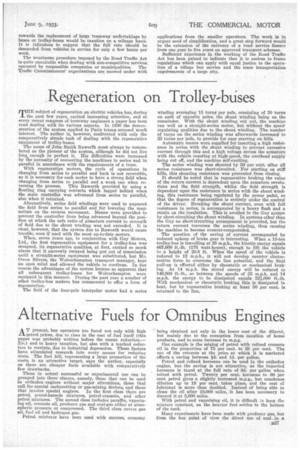Regeneration on Trolley-buses
Page 51

If you've noticed an error in this article please click here to report it so we can fix it.
TEE subject of regeneration on electric vehicles has, during the past few years, excited increasing attention, and at every recent congress of tramway engineers a paper has been read dealing with its various aspects. In 1030 the demonstration of the system applied to Paris trams aroused much interest. The author is, however, confronted with only the comparatively simple task of dealing with the regenerative equipment of trolley-buses.
The name of John Smith Rawor-th must always be remembered as the pioneer of the system, although he did not live long, ,enough to perfect it. His difficulties were increased by the necessity of connecting the machines in series and in parallel in accordance with the requirements of a tram.
With regeneratiye motors, the cycle of operations in changing from series to parallel and back is not reversible, as it is necessary for each motor to have a strong field when changing from series to parallel and a weak one when reversing the process. This Raworth provided by using a floating ring carrying contacts which lagged behind when the main controller was advanced from series to parallel, also when it returned.
Alternatively, series field windings were used to augment the field from series to parallel and for lowering the magnetism on the reverie movement. Means were provided to prevent the controller from being advanced beyond the position at which the safe ratio of armature current to strength of field due to the shunt winding was not exceeded. It is clear, however, that the system due to Raworth would cause trouble, even if used with the most up-to-date motors.
When, seven years ago, in conjunction with Guy Motors, Ltd., the first regenerative equipment for a trolley-bus was designed, its regenerative qualities, at first, excited so much alarm that it narrowly escaped being put out of commission until a straight-series equipment was substituted, but Mr. Owen Silvers, the Wolverhampton transport manager, kept an open mind and allowed the vehicle to continue. in due course the advantages of the system became so apparent that all subsequent trolley-buses for Wolverhampton were equipped in this manner. During the past year a number of other trolley-bus makers has commenced to offer a form of regeneration.
The field of the four-pole interpolar motor had a series winding averaging 15 turn S per pole, consisting 0of 30 turns on each of opposite poles, the shunt winding being on the remainder. With the shunt winding cut out, the machine ran well as a straight-series motor, but without the speedregulating qualities due to the shunt winding. The number of turns on the series 'winding was afterwards increased to 25 turns per pole, to provide for easy starting on hills.
Automatic means were supplied for inserting a high resistance in series with the shunt winding to prevent excessive current through this and a high voltage across the armature with the vehicle coasting at higle speed, the overhead supply being cut off, and the machine self-exciting.
The aeries winding was shunted by 50 per cent, after all series resistance was short-circuited. For starting on stiff hills, this shunting resistance was prevented from closing.
It should be noted that in regenerative braking the value of the return current is dependent upon the armature revolutions and the field strength, whilst the field strength is dependent upon the resistance in series with the shunt winding, this resistance being regulated by the power pedal, so that the degree of regeneration is entirely under the control of the driver. Breaking the shunt current, even with full resistance in series, is accompanied by a heavy flash and a strain on the insulation. This is avoided in the Guy system by short-circuiting the shunt winding. In systems other than the Guy no short-circuiting arrangement is provided, but the return current traverses the series winding, thus causing the machine to become counter-compounded.
The question of the saving of current accompanied by reduced upkeep of brake gear is interesting. When a 10-ton trolley-bus is travelling at 25 m.p.h., the kinetic energy equals 467,600 ft.-lb. (176 watt-hours), enough to lift the vehicle to a height of 20.8 ft. When the speed of the vehicle is reduced to 12 m.p.h., it will not develop counter electromotive force to overcome the line potential, and the final pull-up is effected either by rheostatic or mechanical braking. At 14 m.p.h. the stored energy will be reduced to 146,600 ft.-lb., so between the speeds of 25 m.p.h. and 14 m.p.h. the energy to be dissipated equals 321,000 ft.-lb. With mechanical or rheostatic braking this is dissipated in heat, but by regenerative braking at least 50 per cent, is returned to the line.




























































































